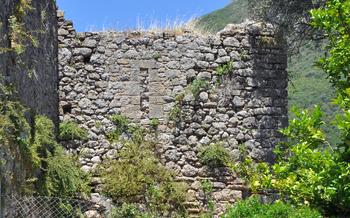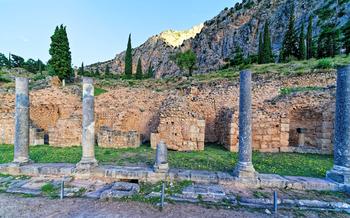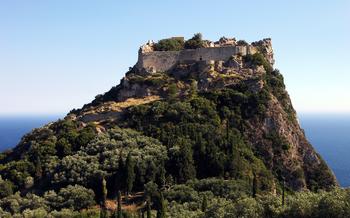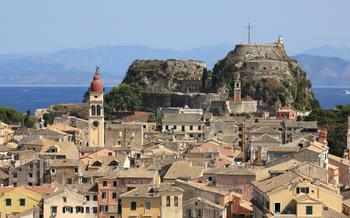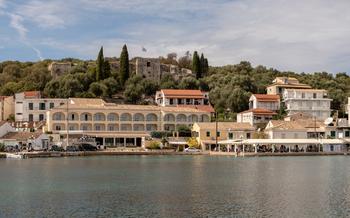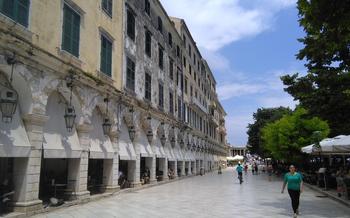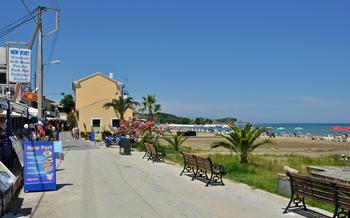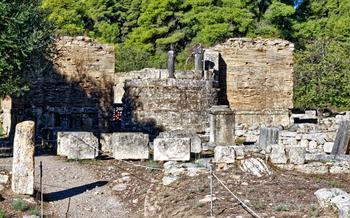
Antinioti Lagoon Nature Reserve
- Location and Accessibility
- Best Time to Visit
- Things to Do
- Wildlife
- Flora and Fauna
- History and Culture
- Research and Conservation
- Visitor Facilities
- Photography Opportunities
- Tips for Visitors
- Accommodation and Dining
- Nearby Attractions
- Sustainable Tourism
- Insider Tip: Unveiling the Hidden Gems of the Antinioti Lagoon Nature Reserve
Location and Accessibility
The Antinioti Lagoon Nature Reserve is situated on the south-eastern coast of Corfu, Greece, approximately 20 kilometers from Corfu Town. It encompasses the Antinioti Lagoon, which is a shallow coastal lagoon separated from the Ionian Sea by a narrow strip of land. To reach the reserve, visitors can take the scenic coastal road from Corfu Town towards Lefkimmi, and then follow the signs for Antinioti. The reserve is well-connected by public transportation, with regular bus services operating from Corfu Town to Antinioti village. There are also several tour operators that offer guided excursions to the reserve, providing a convenient option for those who prefer a hassle-free experience.
Best Time to Visit
The best time to visit the Antinioti Lagoon Nature Reserve is during the spring (April-May) or autumn (September-October) when the weather is mild and pleasant. During these seasons, visitors can enjoy comfortable temperatures, clear skies, and fewer crowds, making it ideal for outdoor activities and wildlife watching.
Summer months (June-August) can be hot and humid, with temperatures often reaching the high 30s Celsius. While the lagoon and surrounding areas remain beautiful, the intense heat may not be suitable for everyone, particularly those sensitive to warm weather. Additionally, the increased number of tourists during this period can make it more challenging to fully appreciate the tranquility and natural beauty of the reserve.
Winter (November-March) brings cooler temperatures, occasional rainfall, and stronger winds. Although the reserve remains open, some activities, such as boat tours or kayaking, may be limited or unavailable due to weather conditions. However, the winter season offers a unique opportunity to observe migratory birds that seek refuge in the lagoon during this time.
Things to Do
The Antinioti Lagoon Nature Reserve offers a wide range of activities for visitors to enjoy. Whether you're a nature enthusiast, an avid birdwatcher, or simply looking for a peaceful retreat, there's something for everyone.
One of the most popular activities is birdwatching. The reserve is home to a diverse array of bird species, including flamingos, herons, egrets, and various migratory birds. Visitors can spend hours exploring the different habitats and observing the birds in their natural environment.
For those who prefer a more active experience, hiking trails wind through the reserve, offering stunning views of the lagoon and the surrounding countryside. The trails range from easy to challenging, so there's something for all fitness levels.
Photography enthusiasts will also find plenty of opportunities to capture stunning images of the reserve's landscapes, wildlife, and sunsets. The lagoon's unique beauty provides a perfect backdrop for photography, and there are many spots where visitors can set up their cameras and capture unforgettable moments.
Guided tours are available for visitors who want to learn more about the reserve's history, ecology, and wildlife. These tours are led by experienced naturalists who can provide insights and information that visitors might not otherwise discover on their own.
No matter how you choose to spend your time in the Antinioti Lagoon Nature Reserve, you're sure to have a memorable and enriching experience.
Wildlife
The Antinioti Lagoon Nature Reserve teems with diverse and captivating wildlife. The reserve's unique habitats support a rich array of bird species, including migratory waterfowl, seabirds, and birds of prey. Among the most common and easily spotted are the elegant flamingos, with their striking pink plumage, and the graceful herons, gliding effortlessly through the air. Visitors can also catch a glimpse of the elusive bittern, a secretive bird with a distinctive booming call, and the shy purple gallinule, with its vibrant purple plumage.
In addition to its avifauna, the reserve is home to various mammals, reptiles, and amphibians. The most notable mammal species include the European otter, an endangered species that can be spotted along the lagoon's shores, and the Mediterranean monk seal, a critically endangered seal that occasionally visits the reserve's waters. Visitors may also encounter various reptile species, such as the Hermann's tortoise, a small and harmless tortoise commonly found in the reserve's scrubland habitats.
The lagoon's diverse plant life provides a vital habitat for various invertebrate species, including dragonflies, butterflies, and beetles. These insects play a crucial role in pollinating plants and supporting the food chain. The reserve is also home to a variety of amphibians, such as the agile frog and the green toad, which can be found in the lagoon's freshwater habitats.
Flora and Fauna
The Antinioti Lagoon Nature Reserve is home to a diverse array of flora and fauna, reflecting the unique ecosystems found within the reserve. The lagoon's brackish waters support a variety of aquatic plants, including reeds, rushes, and water lilies, which provide food and shelter for numerous bird species. The surrounding salt marshes and sand dunes host various halophytes, or salt-tolerant plants, adapted to the harsh conditions.
The reserve's terrestrial habitats, such as pine forests, olive groves, and maquis shrublands, support a rich diversity of plant species, including wildflowers, herbs, and shrubs. These habitats provide nesting and feeding grounds for a variety of birds, including warblers, finches, and owls.
The lagoon's diverse habitats also support a variety of animal species. Amphibians, such as frogs and toads, thrive in the wetland areas, while reptiles, including lizards and snakes, can be found in the drier habitats. Mammals, such as foxes, hares, and hedgehogs, roam the reserve, while bats are active at night.
The reserve's ecosystems play a crucial role in maintaining biodiversity by providing essential habitats for a wide range of species. The lagoon's shallow waters serve as a nursery for fish and other aquatic organisms, while the surrounding habitats offer food, shelter, and breeding grounds for various terrestrial species.
However, the reserve faces challenges from invasive species, such as the red-eared slider turtle, which can compete with native species for resources. Conservation efforts focus on controlling invasive species, protecting and restoring habitats, and monitoring the reserve's biodiversity to ensure the long-term health of its ecosystems.
History and Culture
The Antinioti Lagoon Nature Reserve has a rich and diverse history, dating back to ancient times. The area has been inhabited since the Neolithic period, and there is evidence of human activity from the Bronze Age and Classical Greek periods. In the Middle Ages, the lagoon was part of the Byzantine Empire, and it was later ruled by the Venetians and the Ottomans.
The reserve was established in 1993 to protect the unique natural and cultural heritage of the area. It is home to a number of historical and cultural landmarks, including the ruins of a Byzantine church, a Venetian watchtower, and a traditional Greek windmill. The reserve also plays an important role in the local community, providing a place for recreation, education, and scientific research.
The Antinioti Lagoon Nature Reserve is a living testament to the rich history and culture of the Corfu region. It is a place where visitors can learn about the past while enjoying the beauty of the natural world.
Research and Conservation
The Antinioti Lagoon Nature Reserve is a vital site for scientific research and conservation efforts. Researchers from various institutions conduct studies to understand the reserve's ecosystems, monitor wildlife populations, and assess the impact of human activities. These studies contribute to the development of conservation strategies and management plans to protect the reserve's unique biodiversity.
Conservation efforts focus on preserving the lagoon's habitats, restoring degraded areas, and protecting endangered species. The reserve's management team works closely with local communities and organizations to promote sustainable practices and raise awareness about the importance of conservation. Visitors can contribute to these efforts by following the reserve's regulations, minimizing their impact on the environment, and supporting local conservation initiatives.
One of the ongoing research projects in the reserve is the study of the migratory patterns of birds that use the lagoon as a resting and feeding ground. Researchers use birdwatching, telemetry, and other techniques to track the movements of these birds, gaining insights into their behavior, habitat preferences, and conservation needs.
Another important aspect of conservation work in the reserve is the restoration of degraded habitats. The management team has undertaken projects to replant native vegetation, create new wetlands, and improve water quality. These efforts aim to restore the lagoon's natural ecosystems and provide suitable habitats for various plant and animal species.
The Antinioti Lagoon Nature Reserve is a valuable asset for scientific research and conservation. By supporting these efforts, visitors can contribute to the protection and understanding of this unique and fragile ecosystem.
Visitor Facilities
The Antinioti Lagoon Nature Reserve is committed to providing visitors with a welcoming and informative experience. The reserve offers a variety of visitor facilities to enhance your visit.
A modern visitor center serves as a starting point for your journey into the reserve. Here, you can gather information, purchase tickets, and learn about the diverse ecosystems and wildlife inhabiting the lagoon. Knowledgeable staff is on hand to answer questions and provide guidance.
Throughout the reserve, well-maintained trails and boardwalks allow visitors to explore the different habitats and get closer to nature. These paths are designed to minimize impact on the environment while providing safe and accessible access.
For a more in-depth experience, guided tours are available. Led by experienced naturalists, these tours offer a deeper understanding of the reserve's ecology, history, and conservation efforts. Visitors can choose from various tour options tailored to different interests and abilities.
To ensure a comfortable and enjoyable visit, the reserve provides basic amenities such as restrooms, drinking water stations, and designated picnic areas. These facilities are strategically placed to blend seamlessly with the natural surroundings.
The Antinioti Lagoon Nature Reserve is committed to accessibility for all visitors. Accessible trails, ramps, and viewing platforms allow individuals with disabilities to fully experience the reserve's beauty and wonder.
Photography Opportunities
The Antinioti Lagoon Nature Reserve offers a wealth of photography opportunities for enthusiasts of all levels. The diverse landscapes, rich wildlife, and vibrant colors of the reserve provide ample subjects for capturing stunning images.
Photographers can capture the serene beauty of the lagoon's waters, reflecting the sky and surrounding greenery. The lush vegetation, including wildflowers, reeds, and trees, creates a picturesque backdrop for nature shots. The reserve is also home to a variety of birds, from elegant flamingos to graceful herons, providing opportunities for bird photography.
The best time for photography is during the early morning or late afternoon when the light is soft and golden, creating a magical atmosphere. The reserve's diverse habitats, from the lagoon itself to the surrounding wetlands and forests, offer a range of photographic possibilities.
For those interested in capturing the reserve's wildlife, patience and stealth are key. Using a telephoto lens can help photographers get close-up shots of birds and other animals without disturbing them. It is important to remember that the reserve is a protected area, and visitors should always respect the wildlife and their habitat.
For those looking to enhance their photography skills, there are workshops and tours led by experienced photographers who can provide guidance and tips on capturing the best images. These workshops often cover topics such as composition, lighting, and post-processing techniques.
Tips for Visitors
To ensure a safe and enjoyable visit to the Antinioti Lagoon Nature Reserve, visitors should follow a few simple tips. First and foremost, it is essential to respect the natural environment and minimize your impact. Stick to designated trails, avoid disturbing wildlife, and dispose of waste properly.
To make the most of your visit, plan and prepare accordingly. Wear comfortable clothing and sturdy shoes suitable for walking or hiking. Bring water, snacks, and sunscreen, as there are limited facilities within the reserve. Binoculars and a camera are recommended for wildlife enthusiasts and photographers.
Before your visit, check the reserve's website or contact the local visitor center for information on guided tours or programs. These tours can provide valuable insights into the reserve's ecosystems and wildlife. For photography enthusiasts, workshops or tours led by experienced photographers can offer guidance on capturing stunning images.
Finally, remember that the reserve is home to various wildlife, including birds that may be nesting or raising young. Be mindful of your noise levels and movements to avoid disturbing them. Observe wildlife from a distance and avoid approaching or feeding animals.
Accommodation and Dining
The Antinioti Lagoon Nature Reserve is situated in a relatively remote area, but there are several accommodation options available nearby. Visitors can choose from a range of hotels, guesthouses, and camping facilities in the surrounding towns and villages. For a truly immersive experience, consider staying in a traditional Greek village guesthouse, where you can enjoy local hospitality and authentic cuisine.
Dining options in the area are limited, but there are a few local restaurants and cafes that offer traditional Greek dishes. Be sure to try fresh seafood, which is a specialty of the region. For a unique culinary experience, visit one of the local tavernas and indulge in delicious homemade Greek dishes prepared with fresh, locally sourced ingredients.
Nearby Attractions
The Antinioti Lagoon Nature Reserve is nestled amidst a region rich in natural beauty and cultural heritage. Just a short distance away, visitors can explore other captivating destinations that offer diverse experiences. The nearby village of Antinioti, with its traditional architecture and warm hospitality, invites travelers to immerse themselves in local life. For history enthusiasts, the Angelokastro Castle, perched atop a hill overlooking the Ionian Sea, offers a glimpse into the region's past. Nature lovers can venture to the nearby Marathias Beach, renowned for its crystal-clear waters and scenic views. The vibrant city of Corfu, with its Venetian-influenced architecture, lively atmosphere, and plethora of attractions, is also within easy reach. Whether seeking historical wonders, picturesque landscapes, or urban adventures, visitors can find a wealth of options to complement their visit to the Antinioti Lagoon Nature Reserve.
Sustainable Tourism
The Antinioti Lagoon Nature Reserve, like many natural treasures, requires responsible and sustainable tourism practices to maintain its delicate ecosystem. As a visitor, you can contribute to its preservation by following these guidelines:
-
Respect the natural environment: Avoid littering, disturbing wildlife, or damaging plants. Stick to designated trails to minimize your impact on the reserve's ecosystem.
-
Minimize your carbon footprint: Opt for eco-friendly transportation options, such as walking, cycling, or using public transportation. Consider carpooling or renting a hybrid/electric vehicle if necessary.
-
Support local businesses: Choose accommodations and dining options that prioritize sustainability. Look for hotels or guesthouses that have green certifications or make efforts to reduce their environmental impact. Support local restaurants that use fresh, locally sourced ingredients.
-
Educate yourself and others: Learn about the importance of the Antinioti Lagoon Nature Reserve and its conservation efforts. Share your knowledge with fellow travelers and encourage them to adopt sustainable practices.
By embracing sustainable tourism practices, you can help protect the natural wonders of the lagoon for future generations to enjoy. Remember, every choice you make as a visitor has an impact on the environment, so be mindful and make responsible decisions.
Insider Tip: Unveiling the Hidden Gems of the Antinioti Lagoon Nature Reserve
For an unforgettable experience, venture off the beaten path to discover the secluded Turtle Cove, a hidden gem nestled within the Antinioti Lagoon Nature Reserve. This tranquil haven serves as a nesting ground for sea turtles, offering a rare chance to witness these magnificent creatures up close. As you paddle through the crystal-clear waters on a guided kayak tour, keep an eye out for turtles gracefully gliding beneath the surface. Remember to maintain a respectful distance and avoid disturbing their natural habitat. The reserve's knowledgeable guides will share fascinating insights into the turtles' behavior and conservation efforts, making this an educational and awe-inspiring experience you won't soon forget.
